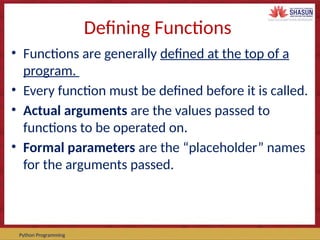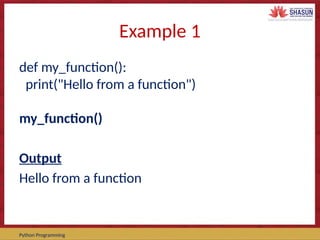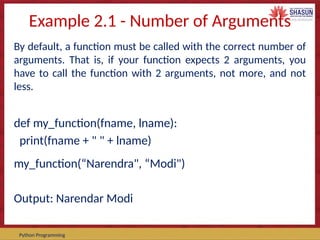Functions in python programming and its calling statement
- 1. Course Code – Course Name Prepared by: Python Programming Unit III • Functions • Program Routines • Defining Functions • Calling Value-Returning Functions- Calling Non- Value-Returning Functions • Parameter Passing - Keyword Arguments in Python • Default Arguments in Python-Variable Scope
- 2. Course Code – Course Name Prepared by: Python Programming Program Routine • A program routine is a named group of instructions that accomplishes some task. • A routine may be invoked (called) as many times as needed in a given program. A function is Python’s version of a program routine.
- 3. Course Code – Course Name Prepared by: Python Programming Program Routine • When a routine terminates, execution automatically returns to the point from which it was called. Such routines may be predefined in the programming language, or designed and implemented by the programmer.
- 4. Course Code – Course Name Prepared by: Python Programming Function • A function is a block of code which only runs when it is called. • We can pass data, known as parameters, into a function. • A function can return data as a result.
- 5. Course Code – Course Name Prepared by: Python Programming How function works in Python
- 6. Course Code – Course Name Prepared by: Python Programming Defining Functions • The first line of a function definition is the function header. • A function header starts with the keyword def, followed by an identifier (avg), which is the function’s name. • The function name is followed by a comma-separated list of identifiers (n1,n2,n3) called formal parameters , or simply “parameters.” • Following the parameter list is a colon ( : ). • Following the function header is the body of the function, a suite (program block) containing the function’s instructions. • As with all suites, the statements must be indented at the same level, relative to the function header.
- 7. Course Code – Course Name Prepared by: Python Programming Defining Functions • Functions are generally defined at the top of a program. • Every function must be defined before it is called. • Actual arguments are the values passed to functions to be operated on. • Formal parameters are the “placeholder” names for the arguments passed.
- 8. Course Code – Course Name Prepared by: Python Programming Example 1 def my_function(): print("Hello from a function") my_function() Output Hello from a function
- 9. Course Code – Course Name Prepared by: Python Programming Example 2 - Arguments def my_function(fname): print(“Welcome” + fname ) my_function(“SAM") my_function(“John") my_function(“William") Output Welcome SAM Welcome John Welcome William
- 10. Course Code – Course Name Prepared by: Python Programming Example 2.1 - Number of Arguments By default, a function must be called with the correct number of arguments. That is, if your function expects 2 arguments, you have to call the function with 2 arguments, not more, and not less. def my_function(fname, lname): print(fname + " " + lname) my_function(“Narendra", “Modi") Output: Narendar Modi
- 11. Course Code – Course Name Prepared by: Python Programming Example 2.2 - Number of Arguments def my_function(fname, lname): print(fname + " " + lname) my_function("Emil") Output:
- 12. Course Code – Course Name Prepared by: Python Programming Example 2.3 - Arguments def my_function(child3, child2, child1): print("The youngest child is " + child3) my_function(child1 = "Emil", child2 = "Tobias", child3 = "Linus") Output The youngest child is Linus
- 13. Course Code – Course Name Prepared by: Python Programming Example 3 - Default Parameter Value def my_function(country = "Norway"): print("I am from " + country) my_function("Sweden") my_function("India") my_function() my_function("Brazil") Output I am from Sweden I am from India I am from Norway I am from Brazil Function arguments can have default values in Python. We can provide a default value to an argument by using the assignment operator (=). A default argument is an argument that assumes a default value if a value is not provided in the function call for that argument.
- 14. Course Code – Course Name Prepared by: Python Programming Example 3.1 - Default Parameter Value
- 15. Course Code – Course Name Prepared by: Python Programming Example 4 - Passing a List as an Argument def my_function(food): for x in food: print(x) fruits = ["apple", "banana", "cherry"] my_function(fruits) Output apple banana cherry We can send any data types of argument to a function (string, number, list, dictionary etc.), and it will be treated as the same data type inside the function.
- 16. Course Code – Course Name Prepared by: Python Programming Example 5 – Return Values def my_function(x): return 5 * x print(my_function(3)) print(my_function(5)) print(my_function(9)) Output 15 25 45 The statement return [expression] exits a function, optionally passing back an expression to the caller. A return statement with no arguments is the same as return None.
- 17. Course Code – Course Name Prepared by: Python Programming Example 5.1 – Return Values
- 18. Course Code – Course Name Prepared by: Python Programming Example – Pass statement Function definitions cannot be empty, but if you for some reason have a function definition with no content, put in the pass statement to avoid getting an error. def myfunction(): pass
- 19. Course Code – Course Name Prepared by: Python Programming Categories of Functions • Value-Returning Functions • Non-Value-Returning Functions
- 20. Course Code – Course Name Prepared by: Python Programming Value-Returning Functions • A value-returning function is a program routine called for its return value, and is therefore similar to a mathematical function.
- 21. Course Code – Course Name Prepared by: Python Programming • Function avg takes three arguments (n1, n2, and n3) and returns the average of the three. • The function call avg(10, 25, 16), therefore, is an expression that evaluates to the returned function value. • This is indicated in the function’s return statement of the form return expr , where expr may be any expression.
- 22. Course Code – Course Name Prepared by: Python Programming Non-Value-Returning Functions • A non-value-returning function is called not for a returned value, but for its side effects . • A side effect is an action other than returning a function value, such as displaying output on the screen. • There is a fundamental difference in the way that value- returning and non-value-returning functions are called. • A call to a value-returning function is an expression, as for the call to function avg: result = avg(10, 25, 16) * factor. • When non-value-returning functions are called, the function call is a statement. • Since such functions do not have a return value, it is incorrect to use a call to a non-value-returning function as an expression
- 23. Course Code – Course Name Prepared by: Python Programming Non-Value-Returning Functions • In this example, function displayWelcome is called only for the side-effect of the screen output produced. • Finally, every function in Python is technically a value-returning function since any function that does not explicitly return a function value (via a return statement) automatically returns the special value None. Such functions as non- value-returning functions. A non-value-returning function is a function called for its side effects, and not for a returned function value.














![Course Code – Course Name Prepared by:
Python Programming
Example 4 - Passing a List as an Argument
def my_function(food):
for x in food:
print(x)
fruits = ["apple", "banana", "cherry"]
my_function(fruits)
Output
apple
banana
cherry
We can send any data types of argument to a
function (string, number, list, dictionary etc.),
and it will be treated as the same data type
inside the function.](https://image.slidesharecdn.com/functions-240910161324-6a65c4f2/85/Functions-in-python-programming-and-its-calling-statement-15-320.jpg)
![Course Code – Course Name Prepared by:
Python Programming
Example 5 – Return Values
def my_function(x):
return 5 * x
print(my_function(3))
print(my_function(5))
print(my_function(9))
Output
15
25
45
The statement return [expression] exits a function,
optionally passing back an expression to the caller.
A return statement with no arguments is the same as
return None.](https://image.slidesharecdn.com/functions-240910161324-6a65c4f2/85/Functions-in-python-programming-and-its-calling-statement-16-320.jpg)






